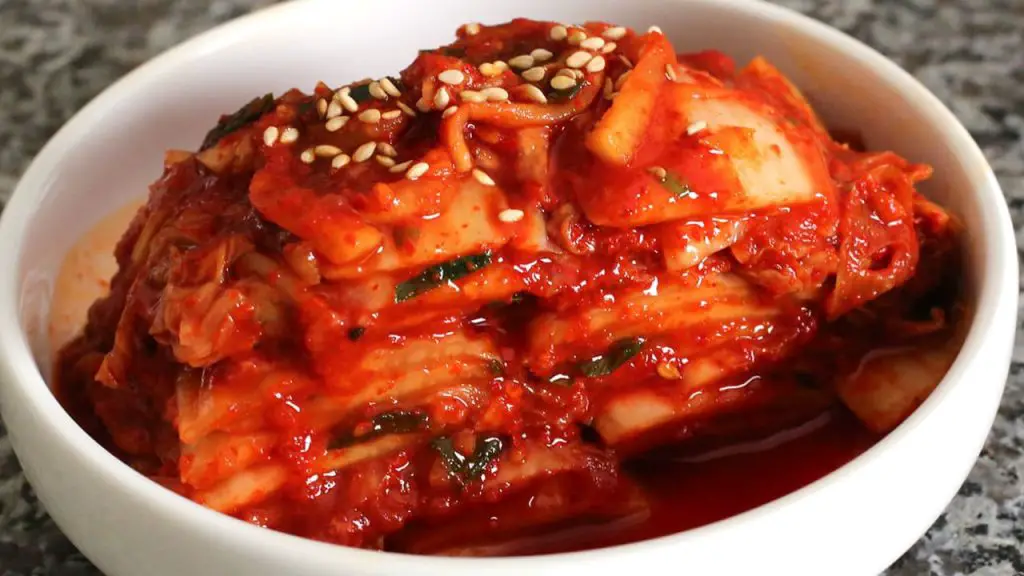You may be wondering what does kimchi taste like? Kimchi is a popular Korean dish made of fermented cabbage and other vegetables. While the ingredients may vary, kimchi typically has a sour and spicy taste.
Some people describe it as tasting similar to sauerkraut or pickles. Others say it has a more unique flavor that’s difficult to describe.

Whether you’ve tried kimchi before or are just curious about what it tastes like, this blog post will give you some ideas about where to find it and how to prepare it yourself.
What is Kimchi?
Kimchi is a traditional Korean dish made of fermented cabbage and a variety of other vegetables. The ingredients are typically marinated in a spicy paste made of chili peppers, garlic, ginger, and other spices.
Kimchi is often served as a side dish, but it can also be used as an ingredient in other dishes such as stews and rice bowls. In addition to its flavorful taste, kimchi is also prized for its health benefits.
The fermentation process breaks down the carbohydrates in the cabbage, making it easier for the body to absorb the nutrients. Fermented foods like kimchi are also rich in probiotics, which have been shown to promote gut health.
With its delicious taste and impressive nutrition profile, it’s no wonder that kimchi has become one of the most popular dishes in Korea.
What Does Kimchi Taste Like?
Kimchi is a traditional Korean dish made from fermented cabbage. It is spicy, salty, and slightly sour, with a pungent odor that some people find unpleasant.
The flavor of kimchi is often compared to that of sauerkraut, although it is typically much spicier.
It is also a common topping for rice and noodles. Although it is commonly associated with Korean cuisine, kimchi is also popular in other parts of Asia, particularly in China and Japan.
While kimchi may not be to everyone’s taste, those who enjoy it often find that it is addictive and crave its unique flavor.
How do you Prepare Kimchi?
The main ingredients in kimchi are cabbage, radish, scallion, garlic, ginger, and chili peppers. Salt is also added to the mix to help with the fermentation process.
To make kimchi, the vegetables are cut into thin strips and soaked in a brine solution for several hours.
This helps to soften the vegetables and allows them to absorb more of the flavors from the spices. After soaking, the vegetables are drained and rinsed before being mixed with the spice paste.
The kimchi is then placed in jars or other airtight containers and left to ferment for several weeks. The finished kimchi can be stored in the refrigerator for up to several months.
When preparing kimchi, it is important to use fresh, high-quality ingredients. This will help to ensure that the kimchi tastes its best and has a good shelf life.
Recipes with Kimchi
There are many different ways to enjoy kimchi. It can be eaten on its own as a side dish or used as an ingredient in other dishes.
Here are some recipes that feature kimchi:
1. Kimchi Fried Rice
This popular dish is made by stir-frying kimchi, rice, and vegetables together in a wok or frying pan. It is often topped with an egg for extra protein.
2. Kimchi Stew
This hearty stew is made with kimchi, pork, and other vegetables. It is usually spicy and can be served with rice or noodles.
3. Kimchi Pancakes
These pancakes are made from a batter of kimchi, flour, and water. They are typically fried in a bit of oil and served with a dipping sauce.
4. Kimchi Soup
This soup is made with kimchi, chicken, and vegetables. It is often served with rice or noodles.
5. Kimchi Dumplings
These dumplings are made with kimchi and pork filling. They can be boiled, steamed, or fried.
6. Tofu Kimchi
Tofu kimchi is a vegan version of the dish that is made with tofu instead of cabbage.
As you can see, there are many different ways to enjoy kimchi. Whether you eat it on its own or use it in a recipe, it is sure to add some flavor to your meal!
Nutritional Value of Kimchi
Kimchi is a traditional Korean dish that is made with cabbage and vegetables. It is typically spicy and tangy, and it is often served as a side dish or condiment.
Although kimchi is often associated with being high in sodium, it actually contains a variety of nutrients that can be beneficial to your health.
For instance, kimchi is a good source of vitamins A and C, as well as iron and calcium. It also contains probiotic bacteria, which may help to improve digestive health.
In addition, the fermentation process that kimchi undergoes creates compounds that have been shown to boost immunity and protect against cancer. As such, kimchi can be a nutritious and flavorful addition to your diet.
Do you Eat Kimchi Hot or Cold?
Kimchi is a traditional Korean dish made of fermented cabbage and spices. It is typically served as a side dish, but it can also be used as an ingredient in other recipes.
While kimchi is traditionally served at room temperature or colder, some people prefer to eat it hot.
When heated, the fermentation process is accelerated, resulting in a more pungent flavor. In addition, the heat helps to release the flavors of the spices and bring out the natural sweetness of the cabbage.
However, kimchi that has been heated for too long can become mushy and lose its crunchy texture. As a result, it is important to find the right balance of heat if you want to enjoy the optimal flavor and texture of kimchi.
Does Kimchi Go Bad?
Kimchi is typically made with cabbage, radish, ginger, garlic, and chili peppers, and it can be enjoyed both fresh and cured.
Because kimchi is fermented, it has a high concentration of live bacteria, which makes it an excellent probiotic food. Probiotics are beneficial for gut health, and they have been shown to boost immunity and improve digestion.
While kimchi is typically consumed within a few weeks of fermentation, it can be stored for longer periods of time. However, the longer kimchi is stored, the sourer it will become.
Additionally, the live bacteria in kimchi will continue to multiply over time, which can make the dish more sour and pungent.
For these reasons, it is best to consume the kimchi within a few months of fermentation. After this time, the flavor and texture of the kimchi may not be as enjoyable.
Conclusion
Kimchi is a spicy and sour fermented cabbage dish that is popular in Korea. It has a strong flavor and can be eaten as a side dish or used as an ingredient in other dishes.
While the taste of kimchi may not be for everyone, it is considered to be a healthy food choice.
Additional Contents



